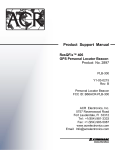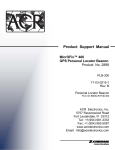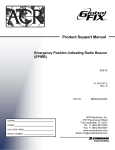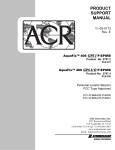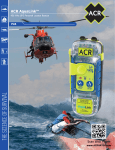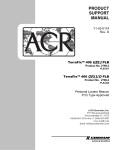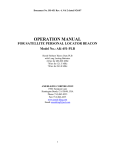Download ACR Electronics PLB-300 - REV B Product specifications
Transcript
PRODUCT SUPPORT MANUAL GPS Personal Locator Beacon Model No.: PLB-300 Product No.: 2897, 2898 Y1-03-0228 Rev. C Personal Locator Beacon (PLB) * * * WARNING * * * THIS TRANSMITTER IS AUTHORIZED FOR USE ONLY DURING SITUATIONS OF GRAVE AND IMMINENT DANGER DELIBERATE MISUSE MAY INCUR A SEVERE PENALTY IF YOU HAVE ANY TROUBLE WITH YOUR NEW 406 BEACON, DO NOT RETURN IT TO THE STORE! CALL ACR ELECTRONICS AT +1 (954) 981-3333. WE WILL HELP YOU RESOLVE ANY PROBLEMS YOU MAY BE EXPERIENCING. MANY QUESTIONS CAN BE ANSWERED OVER THE PHONE. LIMITED WARRANTY This product is warranted against factory defects in material and workmanship for a period of 1 (one) year* from date of purchase or receipt as a gift. During the warranty period ACR Electronics, Inc. will repair or, at its option, replace the unit at no cost to you for labor, materials and return transportation from ACR. For further assistance, please contact our Technical Service Department at ACR Electronics, Inc., 5757 Ravenswood Road, Fort Lauderdale, FL 33312-6645. Email: [email protected], Fax: +1 (954) 983-5087, Telephone: +1 (954) 981- 3333. This warranty does not apply if the product has been damaged by accident or misuse, or as a result of service or modification performed by an unauthorized factory. Except as otherwise expressly stated in the previous paragraph, THE COMPANY MAKES NO REPRESENTATION OR WARRANTY OF ANY KIND, EXPRESS OR IMPLIED, AS TO MERCHANTABILITY, FITNESS FOR A PARTICULAR PURPOSE, OR ANY OTHER MATTER WITH RESPECT TO THIS PRODUCT. The Company shall not be liable for consequential or special damages. To place the warranty in effect, register online at www.acrelectronics.com or return the attached card within 10 days. *Five years for the following products: EPIRB, PLB, S-VDR, SSAS. ©2008 by ACR Electronics, Inc., part of Cobham plc. All rights reserved. Reproduction in whole or in part is permitted only with permission of ACR Electronics, Inc. Ongoing product improvements may change product specifications without notice. Trademarks or registered trademarks are the property of their respective owners. Y1-03-0228 Rev. C 1 Foreword Thank you for purchasing from ACR Electronics, Inc. We design, manufacture and distribute quality products knowing they are used to save lives. Many of our products are required to be tested and approved by regulatory bodies worldwide. We believe in going beyond those specifications to insure our products work when needed in real world conditions. With proper care and maintenance your ACR product will last for years. It is important that you thoroughly read this product support manual to understand the proper care and use of your ACR product. ACR is proud to be certified to ISO 9001:2000, the International Standard for Quality. ACR Electronics diligently works to provide a high quality Product Support Manual, however, despite best efforts, information is subject to change without notice, and omissions and inaccuracies are possible. ACR cannot accept liability for manual contents. To ensure that you have the most recent version of the Product Support Manual, please visit the ACR website at www.acrelectronics.com. Table of Contents SECTION 1 – PRODUCT FEATURES ....................................................................................................................................... 3 1.1 Getting To Know Your Beacon................................................................................................................................... 3 SECTION 2 – REGISTRATION OF 406 MHZ BEACONS ......................................................................................................... 3 2.1 Registration Importance (Registration is FREE and can be updated as many times as you want) .................... 3 2.2 Where to Register ........................................................................................................................................................ 4 2.3 Registration in the United States ............................................................................................................................... 4 2.4 Registration in Canada ............................................................................................................................................... 4 2.5 Registration in Other Countries ................................................................................................................................. 5 2.6 Change of Ownership or Contact Information.......................................................................................................... 5 2.7 Lost or Stolen Beacons .............................................................................................................................................. 5 SECTION 3 – FALSE ALERTS .................................................................................................................................................. 5 3.1 Prevention of False Alerts .......................................................................................................................................... 5 3.2 Reporting of False Alerts ............................................................................................................................................ 6 SECTION 4 – OPERATION ........................................................................................................................................................ 6 4.1 Activation (406 MHz and 121.5 MHz).......................................................................................................................... 7 4.2 406/121.5 Antenna Position ........................................................................................................................................ 7 4.3 Activation with GPS .................................................................................................................................................... 7 4.4 GPS Receiver Orientation ........................................................................................................................................... 8 4.5 Deactivation ................................................................................................................................................................. 8 4.6 Self Test........................................................................................................................................................................ 8 4.7 Battery Witness Seal Life............................................................................................................................................ 8 4.8 GPS Testing ................................................................................................................................................................. 8 SECTION 5 – ACCESSORIES ................................................................................................................................................... 9 5.1 Multi-Function Belt Clip .............................................................................................................................................. 9 5.2 Attachment Clip ......................................................................................................................................................... 10 5.3 Flotation Pouch ......................................................................................................................................................... 10 SECTION 6 – CARE AND MAINTENANCE............................................................................................................................. 10 6.1 Routine Maintenance ................................................................................................................................................ 10 6.2 Battery Replacement ................................................................................................................................................. 11 SECTION 7 – THE SEARCH AND RESCUE SYSTEM ........................................................................................................... 11 7.1 General Overview ...................................................................................................................................................... 11 7.2 Satellite Detection ..................................................................................................................................................... 11 7.3 Global Positioning System (GPS) ............................................................................................................................ 12 SECTION 8 – TECHNICAL INFORMATION ............................................................................................................................ 12 8.1 Characteristics........................................................................................................................................................... 12 8.2 Applicable Documents .............................................................................................................................................. 12 8.3 Specifications ............................................................................................................................................................ 13 WARNING: Contains Lithium Battery To avoid possible fire, explosion, leakage or burn hazard, do not open, recharge, disassemble or heat beacon above +70ºC (+158ºF) or incinerate. These products may contain lithium in the form of a battery. Shipping of hazardous materials requires special handling and documentation. MSDS sheets, along with shipping information, can be found on our website at http://www.acrelectronics.com/hazmat/default.htm. Y1-03-0228 Rev. C 2 SECTION 1 – PRODUCT FEATURES NOTE: Please be aware that, throughout your user manual, reference is made to the beacon ‘BEEPING’. Please note that the ‘beeps’ are of a very high pitched tone that some people are unable to hear. Be aware that the beeps are not the indication of a fully functional beacon but only a guidance to Technicians and Engineers to troubleshoot the unit. The PLB-300™ (referred to as “beacon”) is available in various configurations, as shown in the table below. The ResQFix™ includes accessories oriented for marine/boating use and the MicrOFix™ includes accessories more commonly used in outdoor and aviation activities. 1.1 Product Model Number Product Number ResQFix™ MicrOFix™ PLB-300 PLB-300 2897 2898 Attachment Clip X Multi-Function Belt Clip Flotation Pouch X X Getting To Know Your Beacon Antenna: Wrapped around beacon. FRONT BACK Activation Button Cover UIN Label: Applied at the factory, the 15 character hexadecimal number is unique to each beacon. Registration Decal Supplied By Some Countries: Once the beacon is registered, the label goes here. Keypad: (discussed in section 4) Multi Language Label: This optional label may be applied for ease of use. GPS Antenna Location Battery expiration label with the month/year the battery needs to be replaced. Figure 1 NOTE: The appearance of your beacon may vary slightly from this picture. SECTION 2 – REGISTRATION OF 406 MHz BEACONS 2.1 Registration Importance (Registration is FREE and can be updated as many times as you want) It is mandatory that the owner of this 406 MHz beacon registers it with the national authority*. All 406 MHz beacons transmit a Unique Identifier Number (UIN) when activated. This UIN is programmed in the PLB based on the country in which the beacon was purchased. Registration provides the Search and Rescue (SAR) forces with emergency contact information, and will speed the launch of a rescue operation. The National Authorities use the information to verify if an actual emergency exists. Valuable Search and Rescue personnel are put at risk and resources are wasted every year responding to false alerts. For beacons that are not registered, SAR authorities will not know who you are, or who to contact regarding additional information about your current situation. This could delay the launch of a rescue operation. *The national authority is the governmental body that is responsible for Beacon Registration Database administration in the country for which the beacon is programmed. Y1-03-0228 Rev. C 3 2.2 Where to Register You must register your beacon with the national authority of your resident country. Verify that your beacon’s UIN is programmed for your resident country, regardless of where you do your adventuring. To verify the country for which a beacon is programmed, see the label with the UIN on the back of the unit. Units that do not have a country specified on the UIN label are programmed for the United States. If you should move to a new country, you must register your beacon with the national authority of that country and have the UIN reprogrammed for that country (if necessary). For a list of the national authorities in your area, please view them at http://www.cospas-sarsat.com/Management/listOfParticipants.htm 2.3 Registration in the United States It is your responsibility to register your 406 MHz beacon(s) that are programmed for and purchased in the United States. The national authority that accepts registrations in the United States is the National Oceanic and Atmospheric Administration (NOAA). There are three options by which the beacon can be registered: A. The fastest and easiest way to register your beacon with NOAA is to use the online registration database. For the fastest service, register online! In the United States: www.beaconregistration.noaa.gov B. If the internet is not accessible to you, complete the enclosed registration form. Do not confuse this with the ACR Electronics warranty card. Mail with the pre-addressed, postage paid envelope to: NOAA SARSAT Beacon Registration NSOF, E/SP3 4231 Suitland Road Suitland, MD 20746 C. Faxing your registration is also acceptable. Fax the registration form to fax # +1 (301) 817-4565. Note that the information you provide on the registration form is used only for rescue purposes. Complete and send the registration immediately. All registration forms will be entered in the 406 MHz beacon registration database within 48 hours of receipt. A confirmation letter, a copy of the actual registration and a proof-of-registration decal will be mailed to you within two weeks. When you receive these documents, please check the information carefully, then affix the decal to your beacon in the area marked “BEACON DECAL HERE.” If you do not receive confirmation back from NOAA in the expected timeframe, call toll free +1 (888)-212-7283 for assistance. 2.4 Registration in Canada The national authority in Canada is the NSS (National Search & Rescue Secretariat). Canadian residents can register online at http://beacons.nss.gc.ca/. For more information please contact the NSS at +1 (613) 966-1504 or +1 (800) 727-9414. National Search and Rescue Secretariat 400-275 Slater Street Ottawa, Ontario K1A 0K2 Y1-03-0228 Rev. C 4 2.5 Registration in Other Countries In countries other than the United States and Canada, 406 MHz beacons are registered with that country’s national authority at the time of purchase. The sales agent should assist in filling out the forms and sending to that country’s national authority. To verify that the unit is properly programmed for that country, view the UIN label on the side of the unit. In the event that the beacon is not programmed for the country it has been purchased in, the sales agent, (if properly equipped) can reprogram the unit for that country. 2.6 Change of Ownership or Contact Information It is your responsibility to advise the national authority of any change in the information on the registration form. If the current owner of the beacon is transferring the beacon to a new owner, the current owner is required to inform the national authority by using their online database or by letter, fax or telephone, of the name and address of the new owner. The new owner of the beacon is required to provide the national authority with all of the information requested on the registration form. This obligation transfers to all subsequent owners. Registration forms for the United States are available from NOAA by calling 1 (888) 212-7283 or by visiting our website at www.acrelectronics.com. 2.7 Lost or Stolen Beacons Things you need to do if your beacon is stolen: • Report to your local authorities that the beacon has been lost or stolen. • Contact NOAA at 1-888-212-SAVE (7283), or your national authority, with the following information so your beacon registration information can be updated with the appropriate remarks: o Police Department Name o Police Phone Number o Police Case Number If the beacon were to be activated, the information you provided will be forwarded to the appropriate search and rescue authorities who will ensure that your beacon gets back to you. If someone attempts to register an beacon reported as stolen, NOAA or your national authority will notify the appropriate police department. Visit www.cospas-sarsat.org for more detailed information. SECTION 3 – RESPONSIBLE USE The personal locator beacon is a distress signaling device of last resort, for use when all other means of selfrescue have been exhausted; where the situation is grave and imminent, and the loss of life, limb, eyesight or valuable property will occur without assistance. Deliberate misuse may incur a severe penalty. 3.1 Prevention of False Alerts A false alert is any activation of the beacon, intentional or otherwise, that does not result from a situation of grave and imminent danger. Be sure to do the following: • Register your beacon. This does not reduce false alert rates; however, it does have a dramatic effect on the impact of a false alert. When the beacon is properly registered, the situation can be resolved with a phone call. • Be careful who you leave your beacon with. Make sure that they how to use it, and that they understand the ramifications of causing a false alert. A lot of false alerts are generated by curious individuals. If you notice the beacon is flashing the red or green LED and BEEPING periodically on its own, this likely means it has accidentally been activated and needs to be shut off and reported. The COSPAS - SARSAT satellites detect distress beacon transmissions immediately. These satellites will locate the transmission within a few minutes of the beacon activation. If you're not in distress, you just generated a false alert. NOTE: If you report a false alert and the authorities have not received the signal, don’t worry. This may mean the beacon was deactivated before transmitting the signal. Y1-03-0228 Rev. C 5 3.2 Reporting of False Alerts A false alert must be reported to the nearest search and rescue authorities. The information reported must include the beacon Unique Identifier Number (UIN), date, time, duration and cause of activation, as well as location of beacon at the time of activation. If the beacon is registered outside of the United States, contact your national authority. United States Air Force Rescue Coordination Center (AFRCC) Tel: 1-800-851-3051 False alerts that are rectified must be reported to the AFRCC to let them know that the situation has been corrected and everything is fine. Responsibly reporting these events to the AFRCC or your proper authority will not incur a penalty, but deliberate misuse or not notifying the proper authority may incur a severe penalty. TO REPORT FALSE ALERTS WORLDWIDE, CONTACT THE NATIONAL AUTHORITY WHERE YOUR BEACON IS REGISTERED. SECTION 4 – OPERATION The ResQFix™ and MicrOFix™ 406 GPS beacon models are designed to be manually deployed and activated. They are only to be activated when all other means of self-rescue have been exhausted. When properly registered as required, the activation of the beacon tells Search and Rescue who you are, where you are, and that you are facing a life threatening situation. ON / OFF Button Activation Diagram When activated: (Red LED) 406 MHz Only (Green LED) 406 MHz includes GPS data Self Test / GPS Test Button (IR LED) Programming Interface (Not owner accessible) NOTE: If you notice the PLB is flashing the red or green LED and BEEPING periodically on its own, this likely means it has accidentally been activated and needs to be shut off and reported. Figure 2 - Key Pad Functions Y1-03-0228 Rev. C 6 4.1 Activation (406 MHz and 121.5 MHz) To activate your beacon in a distress situation, follow these steps: 1) Unfasten the antenna from the case. 2) Move it into the upright position (see figure 3 below). 3) Depress the ON/OFF button for 1 full second. You will hear a BEEP and your beacon is now activated. While transmitting your distress signal, the red LED will flash once every 2 seconds alerting you that your beacon is active. An additional BEEP will sound every time your beacon transmits data to the satellites (roughly every 50 seconds). e c d Figure 3 - Activation 4.2 406/121.5 Antenna Position For maximum performance you must deploy the beacon antenna into the proper position (see figure 3). If at all possible, be sure the antenna is positioned facing the sky and avoid submerging in water. This device is intended to operate on or above the ground or while attached to your person above the water line. 4.3 Activation with GPS Your beacon is equipped with an internal GPS receiver. Once activated, the GPS engine will start up and search to find your LAT/LON and incorporate it into your 406 MHz signal. As soon as the GPS receiver acquires good positioning data the red LED will stop blinking and the green LED will begin flashing once every 2 seconds. The same GPS data will be sent with each 406 MHz signal for the next twenty minutes. At that time the internal GPS will start up again, search to find your LAT/LON and incorporate it into your next 406 MHz signal. If for any reason the internal GPS cannot update your LAT/LON, your last position will be used for the next four hours. At that time the green LED will stop blinking and the red LED will flash once every 2 seconds until new GPS data is obtained. Y1-03-0228 Rev. C 7 4.4 4.5 GPS Receiver Orientation When activated it is critical that you do not cover the beacon with any body part, water, clothing, etc. The GPS receiver is located under the bottom portion of the case behind the ResQFix™ or MicrOFix™ logo (see figure 4). To ensure optimum performance of the GPS receiver, the beacon needs to have an unobstructed view of the sky. Avoid submerging the GPS receiver in water if possible. Water will shield and inhibit the GPS receiver and may cause difficulties obtaining your GPS coordinates. Avoid leaning over the beacon to view blinking LED as you may shield the GPS reception. Figure 4 – GPS Receiver Location Deactivation To deactivate your beacon, depress the ON/OFF button for 1 second. Once the beacon is deactivated, all blinking LEDs will stop signifying that the beacon is no longer sending your distress message. 4.6 Self Test ACR strongly recommends performing the self test once per month, or at least two weeks prior to a trip allowing enough time for service should your beacon require it. A self test is initiated by holding the self test button for at least ½ second and less than 5 seconds. Your beacon will sound an initial beep and flash the green LED to signify the test has begun. The green LED will flash a second time to indicate that the self test was successful. NOTE: The beep is a very high pitch that many people are unable to hear. Components Tested: Data Integrity and Memory; 406 MHz Synthesizer; RF Power/Battery; GPS header If a RED LED flashes at the completion of the self test, your beacon has failed. Repeat the self test. If the failure persists, contact ACR Electronics or an authorized Battery Replacement Center for servicing of your beacon. NOTE: During a self test your beacon will send a 406 MHz signal coded as self-test to the satellite system. The 121.5 MHz homing signal is inhibited during self test; this allows you to test your beacon any time during the day without causing false alerts. Self Test Sequences Green LED, 4 BEEPS, Self Test Guide ( Green LED Green LED, Less than 4 BEEPS, Red LED, 4 BEEPS, Red LED Green LED Red LED, Less than 4 BEEPS, Red LED Green LED Red LED) Successful Self Test Failed Self Test – Return beacon to ACR Successful Self Test – At least 1 hour of battery power has been depleted, have battery replaced. Failed self test – Return unit to ACR for service. 4.7 Battery Witness Seal Life If your beacon flashes an initial Red LED at the beginning of the Self Test, this indicates that your electronic witness has been broken and you have used more than 1 hour of battery life. While the beacon will still operate normally in a distress situation, ACR strongly recommends you have your battery replaced and the electronic witness reset to ensure that you will have 24 hours of battery power. 4.8 GPS Testing This test is NOT required as 100% of all GPS receivers that leave ACR have been tested to ensure they perform correctly. However, if you would like to ensure your GPS receiver is working, please follow these instructions very closely. CAUTION: To conserve battery power the following test should not be performed more than once during the five-year life of the battery pack! Y1-03-0228 Rev. C 8 NOTE: The GPS receiver is located under the front portion of the case (see figure 4). It is imperative that the receiver is not obstructed during self test or activation to ensure that the GPS receiver is acquiring your latitude (LAT) and longitude (LON) position. This test must be performed outside with a clear view of the sky. Press the self-test button for greater than 5 seconds. Observe the beacon for the entire GPS test. A BEEP and green LED will indicate that the GPS has been turned ON. The beacon will BEEP every 5 seconds and the GPS will remain ON until LAT/LON coordinates have been obtained or until 10 minutes have elapsed. If good LAT/LON data has been obtained, the GPS will be turned OFF and the green LED will light for at least 3 seconds along with a long beep. This LAT/LON data is not saved for use. The green LED is proof that the GPS is functioning properly and that the beacon is in a location or environment where it can receive the necessary signals from satellites. If the GPS does not acquire good LAT/LON data, the GPS will turn OFF after 10 minutes and a RED LED will light for 3 seconds along with a long beep. GPS Test Sequences (max. 10 minutes) GPS Test Guide Green LED and BEEP at start followed by continuous BEEPS every 5 seconds, Green LED & Long BEEP Successfully acquired GPS data Green LED and BEEP at start followed by continuous BEEPS every 5 seconds, Red LED & Long BEEP GPS data was not successfully acquired SECTION 5 – ACCESSORIES 5.1 Multi-Function Belt Clip The MicrOFix™ comes standard with a multi-function belt clip. To install the clip, simply align the bottom tabs on the clip with the insert holes located on the bottom of the beacon. Snap the clip in place by pressing the top of the clip so that the two top tabs engage in the two insert holes on the top of the beacon (see figure 5). To remove the clip, push up and back on the top tabs one at a time to disengage the clip from the beacon. d The MicrOFix™ clip has been designed to accommodate your extreme adventures. You can secure your beacon directly to backpack webbing straps, life jackets or belts to ensure the beacon is close at hand. ACR recommends that you secure your beacon someplace on your person that is easily accessible in case of an emergency for rapid activation. Ensure the beacon is secured firmly and is protected before heading out to avoid damage or loss. NOTE: ACR recommends that once you have clipped your beacon in place that you also anchor the beacon with the lanyard to your life jacket, backpack, etc. to ensure the unit will not be lost if it should break out of the clip. c Figure 5 - Belt Clip Y1-03-0228 Rev. C 9 5.2 d Attachment Clip The ResQFix™ comes standard with an attachment clip. To install the clip, simply align the bottom tabs on the clip with the insert holes located on the bottom of the beacon. Snap the clip in place by pressing the top of the clip so that the two top tabs engage in the two insert holes on the top of the beacon (See figure 6). To remove the clip, push up and back on the top tabs one at a time to disengage from the beacon. The ResQFix™ clip has been designed to secure your beacon directly to life jacket webbing straps or belts to ensure the beacon is close at hand. ACR recommends that you have a strap on your life jacket in the shoulder area for attachment of the ResQFix™. The beacon should hang with the GPS receiver up in order to give it the best possible view of the sky. It is also recommended that you try your life jacket on in the water to see how you float in it and where to best locate the beacon so that the beacon is not in the water. You may choose to carry your beacon in a pocket but you should have a strap installed on your life jacket to attach the beacon when it is activated. This will leave your hands free while treading water. c Figure 6- Attachment Clip NOTE: ACR recommends that once you have clipped your beacon in place that you also secure the beacon with the lanyard to your life jacket, backpack, etc. to ensure the unit will not be lost if it should break out of the clip. 5.3 Flotation Pouch The ResQFix™ is a Category I beacon thanks to the neoprene flotation pouch attached to the lanyard. The pouch has been designed to work with and without the attachment holster. Simply open the bottom of the pouch using the Velcro and slide the top of the ResQFix™ into the pouch with the GPS receiver exposed through the special cut out hole on the front underneath the ACR logo. The neoprene flotation pouch will accommodate the ResQFix™ and the attachment clip. The neoprene pouch is designed to float the beacon if it is dropped in the water. Figure 7 - Flotation Pouch CAUTION: If you secure additional objects to the neoprene pouch it may sink. WARNING: The ResQFix™ must be removed from its pouch when used in an emergency. SECTION 6 – CARE AND MAINTENANCE 6.1 Routine Maintenance Carefully inspect the beacon case for any visible cracks. Cracks may admit moisture, which could falsely activate the beacon or otherwise cause a malfunction. Any cracking observed should be immediately referred to ACR for evaluation by calling 1-800-432-0227 in the US, or +1-954-981-3333 elsewhere. ACR technical support can also be reached by sending an email to [email protected]. After checking the beacon case for cracks, it may be wiped down with a clean, damp cloth. Do not use any type of cleaner on your beacon. Y1-03-0228 Rev. C 10 6.2 Battery Replacement The battery must be replaced by the date indicated on the beacon or every five (5) years. At each inspection, check the time remaining until replacement is required. The battery should be replaced if the beacon has been activated for any use other than the self test. Always refer all long life battery replacement and other beacon service to a factory authorized service center. Battery replacement includes servicing the beacon by replacing all o-rings, testing the water seal and the electrical properties. NOTE: There are no user serviceable items inside the beacon. DO NOT OPEN THE BEACON. For the nearest location of a Battery Replacement Center, visit our website at www.acrelectronics.com The beacon may or may not require special shipping instructions due to the lithium batteries and changes in shipping regulations. Call ACR’s customer service department at +1 (954) 981-3333 ext. 2110 for proper shipping instructions. SECTION 7 – THE SEARCH AND RESCUE SYSTEM 7.1 General Overview Beacons provide distress alerts via radio transmission on 406 MHz to the LEOSAR satellites of the COSPAS SARSAT network. The ResQFix™ and MicrOFix™ can also transmit a distress alert (acquired by the internal GPS) to the GEOSAR network that includes GPS latitude and longitude coordinates. The message transmitted is unique for each beacon, which provides identification of the transmitter through computer access of registration files maintained by the National Oceanic and Atmospheric Administration or other national authority*. Remember, SAR forces will know who you are and who to contact that might know of your current situation only if your beacon has been properly registered. This will help expedite the launch of a rescue operation. NOTE: 406 MHz beacons are required to have their registration updated every two years. *The national authority is the governmental body responsible for beacon registration database administration for the country for which the beacon is programmed. Once the 406 MHz signal is relayed through the LEOSAR and/or GEOSAR network, SAR forces determine which SAR group is closest. This group proceeds to the beacon using the 121.5 MHz homing frequency. 7.2 Satellite Detection Beacons transmit to the satellite portion of the COSPAS - SARSAT system. COSPAS - SARSAT is an international system that utilizes Russian Federation and United States’ low altitude, near-polar orbiting satellites (LEOSAR). These satellites assist in detecting and locating activated 406 MHz satellite beacons. COSPAS and SARSAT satellites receive distress signals from beacons transmitting on the frequency of 406 MHz. The COSPAS - SARSAT 406 MHz beacon signal consists of a transmission of non-modulated carriers followed by a digital message format that provides identification data. The 406 MHz system uses Satelliteborne equipment to measure and store the Doppler-shifted frequency along with the beacon’s digital data message and time of measurement. This information is transmitted in real time to an earth station called the Local User Terminal (LUT), which may be within the view of the satellite, as well as being stored for later transmission to other LUTs. The LUT processes the Doppler-shifted signal from the LEOSAR and determines the location of the beacon, then the LUT relays the position of the distress to a Mission Control Center (MCC) where the distress alert and location information is immediately forwarded to an appropriate Rescue Coordination Center (RCC). The RCC dispatches Search and Rescue (SAR) forces. Y1-03-0228 Rev. C 11 The addition of the GEOSAR satellite system greatly improves the reaction time for a SAR event. This satellite system has no Doppler capabilities at 406 MHz, but will relay the distress alert to any of the LUT stations. When there is GPS data included in the distress message, SAR authorities instantly know your location to within 110 yards (100 m). This speeds up the reaction time by not having to wait for one of the LEOSAR satellite to pass overhead. Because most of the search and rescue forces presently are not equipped to home in on the 406 MHz Satellite beacon signal, homing must be accomplished at 121.5 MHz. Figure 7- Satellite Coverage 7.3 Figure 8- GEOSAR Satellite Orbits Global Positioning System (GPS) The GPS system is a satellite group that enables a GPS receiver to determine its exact position to within 30 m (100 ft.) anywhere on earth. With a minimum of 24 GPS satellites orbiting the earth at an altitude of approximately 11,000 miles they provide users with accurate information on position, velocity, and time anywhere in the world and in all weather conditions. The ResQFix™ and MicrOFix™ store this data into its distress transmission allowing search and rescue forces to narrow the search into a very small area and thus minimize the resources required, dramatically increasing the effectiveness of the overall operation. Figure 9 – GPS Satellite Orbits SECTION 8 – TECHNICAL INFORMATION 8.1 Characteristics The ResQFix™ and MicrOFix™ are battery operated Personal Locator Beacons. The beacon case, with its antenna, is waterproof, while semiconductor circuits are mounted within the case assembly which also contains the battery power supply. Keypads with “self test” and “ON” buttons are installed on the case, along with an internal beeper and three LEDs. The beacon contains a GPS receiver that will acquire your LAT/LON located under the bottom of the front case. The ResQFix™ and MicrOFix™ meet the requirements of Federal Communications Commission (FCC) Part 95 Subpart K; and European R&TTE Directive. 8.2 Applicable Documents COSPAS - SARSAT C/S T.001 Specification for 406 MHz Distress Beacons COSPAS - SARSAT C/S T.007 406 MHz Distress Beacon Type Approval Standard ETSI 302 152-1 Technical Characteristics of 406 MHz Satellite PLBs RTCM Paper 76-2002/SC110-STD RTCM Recommended Standards for 406 MHz Satellite PLBs Industry Canada RSS-287 Radio Standards Specification for EPIRBs, ELTs and PLBs Canadian NSS-PLB 06 NSS Performance Standard fro 406 MHz PLB Australia/New Zealand AS/NZS 4280.2 406 MHz Satellite Distress Beacons; Part 2: PLBs NOTE: For all other type approval information, please visit our website at www.acrelectronics.com. Y1-03-0228 Rev. C 12 8.3 Specifications 406 MHz Transmitter Frequency 406 MHz Output Power 5 watts Frequency Stability ±2 parts per billion/100ms Digital Message: Format Long message/ Serialized1* Message protocol Standard Location Duration 520 ms Rate 400 bps Encoding Biphase L Modulation ±1.1 radians peak 1* Beacons are shipped from ACR with a Serialized code but can be reprogrammed at a service center to other coded formats including nationality of registration. 121.5 MHz Transmitter Frequency: 121.5 MHz Frequency Tolerance ±50 ppm Output Power 50 mW PEP Morse Code “P” ID Every 50 seconds (approximately) (U.S. Protocol) Modulation Type AM (3K20A3N) Sweep Range 400 to 1200 Hz Sweep Rate 3 Hz Duty Cycle 37.5% Morse P AM (2K00A2A) (U.S. Protocol) Antenna Frequency 406 & 121.500 MHz Polarization Vertical VSWR Less than 1.5/1 General/Environmental Minimum Battery Operating Life +24 hours minimum @ -20°C to +55°C (-4°F to +131°F) Battery Replacement Interval 5 years, after use in an emergency, or expired battery witness seal *Batteries meet the UN Classification for Non-dangerous goods Size of beacon less Antenna 1.25 x 5.81 x 2.31 in (3.71 x 14.75 x 5.8 cm) Material High impact and UV resistant plastic Color ACR-treuse™ (High Visibility Yellow) Weight 9.8 oz (277 grams) w/o holster Factory Tested to 3.28 ft (1 m) for 1 hour and to 32.8 ft (10 m) for Waterproof 10 minutes, both at room temperature The beacon will not float without ACR pouch, included with the Buoyancy ResQFix™ and not sold separately. Temperature Range Operating -20°C to +55°C (-4°F to +131°F) Storage: -40°C to +70°C (-40°F to +158°F) Y1-03-0228 Rev. C 13 DE ECLARA ATION OF O CONF FORMIT TY AC CR Electron nics hereby y declaress that the following products p arre in confo ormity with h Directive 199 99/5/EC off the Europ pean Parliam ment and of o the Coun ncil of 9 Ma arch 1999 on Radio Equipment E and d Telecom mmunication ns Termina al Equipm ment (R&TT TE), and has been type examined as desscribed in this t Declara ation. In acccordance with w the Dirrective, the product will be marke ed with the CE E conformityy marking as a follows: Pro oduct: Pers sonal Locattor Beacon (PLB) with h GPS Rece eiver Trad de Names: ResQFix and a MicrOFix Mod del: PLB-30 00 otified Body: No Qine etiQ (UK) Notified N Bod dy No. 0191 1 Cod dy Technolo ogy Park Ively y Road, Farnborough Ham mpshire, GU U14 0LX, United U Kingd dom Certtificate No. QQ-RTTE--02/07-01 Re egulations and Sta andards: IEC EN 60945: 2002 ETS SI EN 302 152-1: 1 V1.1.1 (2003-11 1) COS SPAS - SARSAT C/S T.001 – Isssue 3 - Revvision 7 COS SPAS - SARSAT C/S T.007 – Isssue 4 - Revvision 0 Manufacturer: ACR R Electronics Inc. I 5757 7 Ravenswood Road Fort Lauderdale, FL F 33312 A USA European Representtative: ACR Electro onics Inc. (European Office) O 1 Rose Cotta ages, Pitmore e Lane, Sway, Lymin ngton, Hampsshire SO41 6BX UK gned on be ehalf of AC CR Electronics Inc. Sig Sign ned: _____ __________ _________ __________ _________ __ Nam me: Title e: Document PLB-300-004 4 Thomas Pa T ack Datte: May 25 5, 2010 D Director - New N Produc ct Develop pment This Declaration D co omplies with ISO/IEC 17 7050-1:2004 ACR Electro onics, Inc. is registered by UL to ISO 9001:2008 Y1--03-0228 Revv. C 14

















